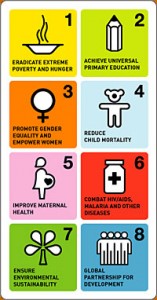By Kunda Dixit
TOKYO, Oct 13 (TerraViva) – After a decade of progress, it had seemed that the world was on target to meet many of the Millennium Development Goals (MDGs) that were set in 2000 to halve extreme poverty and hunger, boost health and literacy in 15 years.
But the global finance and food crisis have threatened to reverse gains.
For the first time in many years, hunger worldwide is increasing instead of decreasing – mainly because of the widespread drought this summer and the increasing use of farmlands for the production of biofuels. Food prices have soared to all-time highs, affecting vulnerable populations in poor countries the most.
And all this is coinciding with the global economic crisis, which has affected aid flows and investment in developing countries, undermining their capacity to cope with the crisis of inflation, food security and development.
With three years to go before the target date, the United Nations is now trying to come up with new goals for beyond 2015 that will draw lessons from the current MDG campaign, and look at the new challenges that have come up since 2000. 
In September, the UN set up a High-level Panel post-2015 Task Team that UNDP Administrator Helen Clark says will look at the new development landscape and look at new areas not tackled in the current goals, like equality, inclusiveness, sustainability, conflict and climate change.
Clark was speaking at a panel at the World Bank-IMF Annual Meetings in Tokyo this week with the World Bank President Jim Yong Kim, Homi Kharas of the Brookings Institution, who is the lead author of the High-level Panel, and its other members, including Liberian President Ellen Johnson Sirleaf and Gunilla Carlsson, Sweden’s Foreign Minister.
Most panelists agreed that the world had changed dramatically since 2000. It had become much more interconnected, and the new goals should not just be goals for developing countries but for the whole world. The global financial crisis was worsening inequality, global climate change was affecting food security, and there was a danger that there would be a reversal of even the MDG goals that had been attained so far.
The High-level Panel has its work cut out to be able to present its report to the UN Secretary-General by end-May 2013. And its main challenge will be to ensure that new post-MDG goals, whatever they are, also have the ability to absorb global financial, climate and natural shocks. This would mean that poor countries should not just be trying to lift their populations out of poverty, but also develop “shock absorbers” and social stabilisers to deal with them.
World Bank President Kim weighed in with his own priorities for the post-MDG plan: to look beyond just GDP growth, pay more attention to equity and inclusion, and give special attention to fragile and conflict states. While the 2015 target called for halving extreme poverty, Kim is now on a campaign to put international development organisations to agree to an ambitious campaign to eradicate extreme poverty altogether by 2030.
However, to really go to the heart of the reasons why some countries have lagged behind on meeting MDG targets and not others, some basic questions need to be asked not, just about what areas they lag behind in, but also why.
One key issue is that while targets are global, meeting them is a local matter that hinges on governance, leadership, accountability and transparency. These are generally beyond the purview of the United Nations, international creditors or aid agencies.
Sometimes, countries make progress despite conflict and political disarray. Nepal, for example, has met most of its MDG targets ahead of schedule, more than halving maternal and child mortality, doubling female literacy and reducing extreme poverty despite a 10-year conflict, bad governance, endemic corruption and government mismanagement.
The MDGs have worked because they have packaged development goals neatly into targets that are easy to explain and monitor. They have also galvanised the UN, governments and donors to row in the same direction.
However, while MDGs quantify progress, they don’t answer questions about the structural international and domestic factors that keep countries poor.
Not many of donor countries that once pledged to set aside 0.7 percent of their GDP for ODA have met their target, for instance. Also, there has been a net outflow of resources from poor countries to rich. Most developing countries pay more in debt servicing and imports to advanced countries than they receive in aid or remittances. As someone said, trying to achieve MDGs in a situation like this is like trying to go up in a down escalator.
The Tokyo meetings this week were a venue for the new World Bank President to give himself and his Bank the challenge to eradicate poverty in the next 15 years after 2015. In numerous speeches he made here, he kept asking “what will it take” to achieve that goal, and his staff distributed black t-shirts that said ‘End Poverty’ and the Bank even has a twitter hashtag, #whatwillittake.
Said Kim: “It is time to move from dreaming of a world free of poverty to achieving it. It is time to bend the arc of history.”
In the final analysis, whatever the global goals, it will ultimately come down to improving local governance through accountable leadership. That is the way all countries that have made progress have done so. Maybe the hashtag should be: #whyisittakingsolong? (END)






